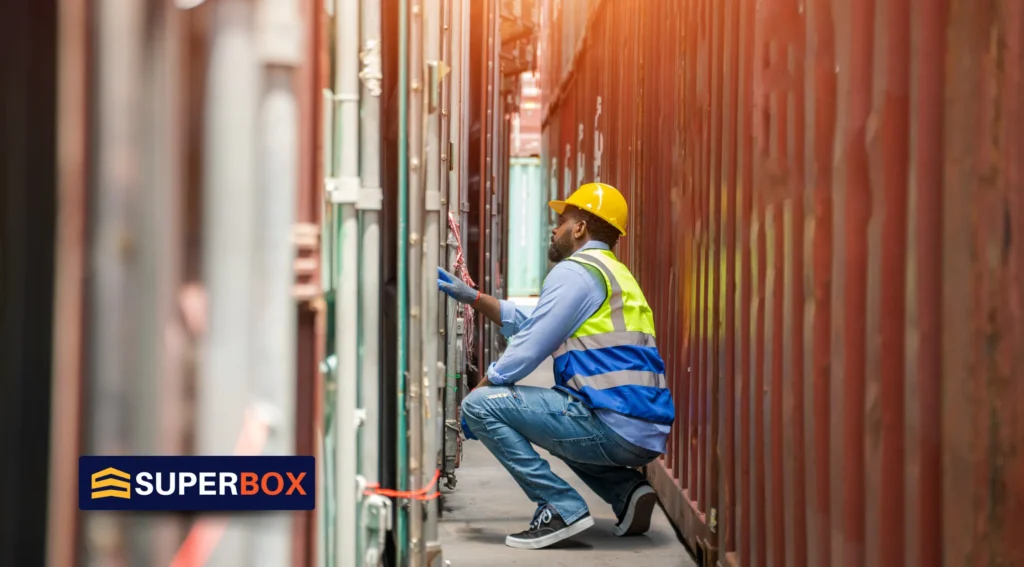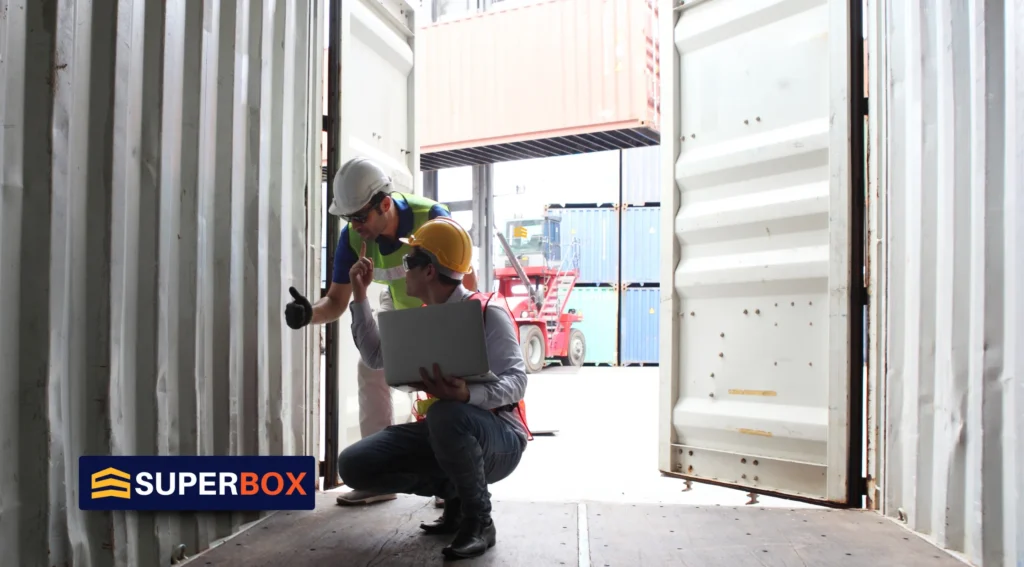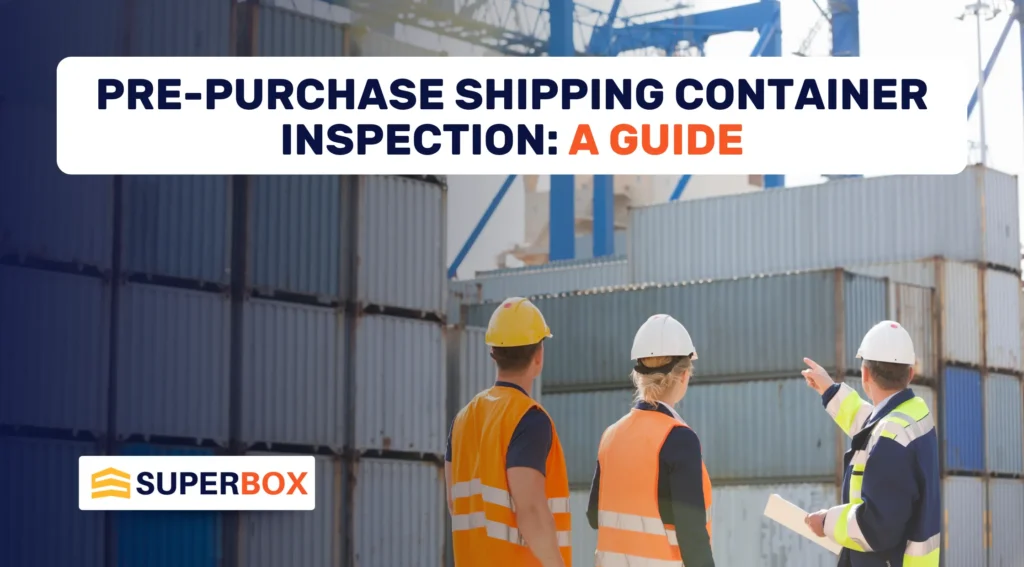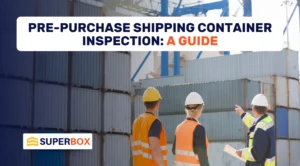Buying a shipping container can be a significant investment, whether you need it for storage, shipping goods, or even as a unique living space. A thorough pre-purchase inspection is crucial to ensure you get the best value for your money and avoid future headaches. This guide will walk you through what to look for during a shipping container pre-purchase inspection, covering essential aspects such as assessing the condition and damage, verifying documentation, and conducting a personal inspection.

Assessing Condition and Damage
When inspecting a shipping container, it’s important to evaluate its condition carefully to ensure it meets your needs. Here are signs of wear and damage to look for that could affect its usability and safety.
Identifying Signs of Damage or Wear and Tear
When inspecting a shipping container, the first step is to assess its overall condition. Pay close attention to the following common signs of damage and wear:
Rust and Corrosion
One of the most common issues with shipping containers is rust and corrosion. Containers are typically made of corten steel, which is designed to resist weathering and corrosion. However, exposure to the elements can lead to structural rust and surface rust over time.
Structural Rust: This type of rust affects the integrity of the container and can compromise its strength. Check the corners, edges, and areas around the doors for any signs of rust that may indicate deeper issues. If the rust is extensive, it could weaken the structure and lead to failure during transport or use.
Surface Rust: While surface rust may not be as concerning as structural rust, it can still affect the container’s appearance and may indicate that the container has been poorly maintained. Consider the amount of surface rust present and whether it is something you are willing to deal with.
Structural Integrity
Assessing the structural integrity of the container is essential. Look for any visible signs of damage that might affect its usability. Check for:
- Dents and Scratches: Minor dents and scratches are normal due to shipping and handling. However, major dents could indicate more significant structural issues. Pay special attention to the corners and edges, as these areas are more susceptible to damage.
- Warping or Bending: Examine the container for any signs of warping or bending. A warped container may not close properly, which could lead to security issues or water ingress.
Cross Members and Steel Beams
The cross members and steel beams are crucial components of a shipping container. These structural elements help support the container’s weight and maintain its shape. During your inspection:
Check for any signs of damage, such as cracks or bends.
- Ensure that the cross members are intact and securely attached to the container walls. If they are damaged or missing, it could compromise the container’s structural integrity.
Understanding Common Issues
Recognizing these common issues is key to assessing whether a shipping container is worth your investment. Consider your intended use for the container—whether it will be used for storage, shipping, or as a modified living space. The acceptable level of wear and tear may vary depending on its purpose.

Verifying Documentation
Ensuring Necessary Documentation
Before finalizing your purchase, ensure that the container has all the necessary documentation. One critical document to verify is the CSC Plate (Container Safety Convention Plate). This plate certifies that the container meets international safety standards and is suitable for shipping purposes.
- Importance of the CSC Plate: Without this certification, you may face issues when trying to use the container for shipping. The CSC plate includes vital information, such as the container’s dimensions, type, and date of manufacture.
- Additional Documentation: Besides the CSC Plate, check for other important documents, including maintenance records, previous ownership history, and inspection reports. Having complete documentation will help you avoid future complications and ensure that you’re buying a quality container.
Compliance with International Standards
Make sure that the container adheres to international standards for shipping containers. This compliance guarantees that the container is safe for transport and will function correctly in the logistics chain.
Familiarize yourself with the relevant international standards and regulations applicable to shipping containers in your region. Understanding these standards can save you time and money in the long run.

Conducting a Personal Inspection
When conducting a personal inspection of a shipping container, it’s crucial to be thorough. Here are some key steps to guide you in your evaluation.
Tips for Effective Inspection
Performing a personal inspection allows you to catch issues that might not be visible in photographs or descriptions. Here are some steps to ensure a thorough inspection:
Steps for Inspection
Start from the Top: Begin your inspection at the roof and work your way down. Check for any signs of leaks, particularly around the roof edges and vents. Ensure that the roof is free from rust or any structural damage.
Examine the Doors: Open and close the doors to ensure they operate smoothly. Check the seals to ensure they are intact and that the doors can close securely.
Inspect the Interior: Once you’ve checked the exterior, inspect the interior of the container. Look for any signs of water damage, mold, or pest infestations. These issues can affect the integrity and usability of the container.
Recognizing Potential Structural Issues
Be vigilant in recognizing potential structural issues that could indicate underlying problems. This includes looking for cracks in the walls or floors. Inspect the walls and floor for any cracks or signs of delamination. Structural issues like these can affect the overall usability of the container.
Importance of Quality Control
Quality control should be a top priority in your purchase inspections. Ensure that the container meets your expectations for quality and condition. If you have any doubts, consider seeking the assistance of a professional inspector who specializes in shipping containers.
Conclusion
A thorough pre-purchase inspection of a shipping container is essential for ensuring that your investment is sound and meets your specific needs. By carefully assessing the condition and damage, verifying necessary documentation, and conducting a personal inspection, you can avoid potential pitfalls and ensure a safe, reliable container for storage, shipping, or even as a unique living space.
Remember to look for signs of rust and structural issues, verify the CSC plate and compliance with international standards, and be vigilant during your inspection process. By taking these steps, you’ll be well-prepared to make an informed decision and enjoy peace of mind with your shipping container purchase.
Make a Smart Investment with SuperBox
When purchasing a shipping container, conducting a thorough pre-purchase inspection is crucial to ensure you make a wise choice. At SuperBox, we offer high-quality shipping containers for sale that have been rigorously checked for reliability and durability. With a diverse selection available, you’re sure to find the ideal container to suit your needs.
Your satisfaction is our top priority, and you can trust that we provide containers that meet your expectations. For more information or to begin your purchase, call us today at 210-557-006. Let SuperBox assist you in confidently securing a high-quality container!


